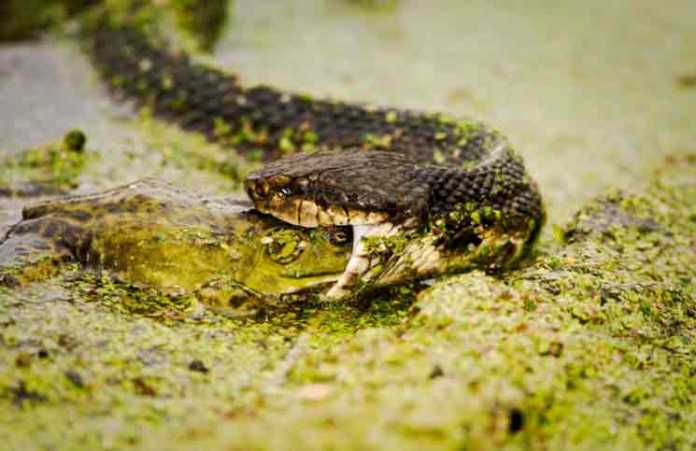If you have any plans to search for Snakes in Florida, read this…
First thing you should know is, there are more than fifty types of Florida snakes that you would encounter in the beautiful sunshine state. Each of those types also has some variants as almost every species has some genetic and mutative tendencies that make them slightly or considerably different. While there is no dearth of Florida snakes, you will not come across many venomous snakes in Florida. More than forty five types among the fifty four odd snakes found in the state are actually non venomous snakes in Florida. However, dangerous encounters with deadly snakes do occur in Florida, as this little boy from Miramar, Broward County, will surely testify…
Early this November, 9-year old Jorge Quinonez was playing outside with his brother and a friend, when he suddenly fell down right on top of a Water Moccasin Snake (that’s the scary snake in the picture above, devouring a frog!). It’s the world’s only semiaquatic viper, it’s venomous and capable of delivering a painful and fatal bite. The snake’s natural reflex was of course to defend itself, and so it did. It instantly bit little Jorge and bore its fangs into the poor kid’s hand, while he was screaming out loud. Luckily the tough kid swayed his arm around and made the snake lose its grip. He then ran to his dad who called 911. They rushed him to the hospital, where Miami-Dade Air Rescue flew in its Venom Response Team to treat Jorge. They immediately injected him with the anti-venom. As his condition stabled, Jorge received a 2nd round of anti-venom. Several days later he was released, and back to school. Jorge survived, but you better know your snakes in Florida…
Watch this great clip where Central Florida Zoo & Botanical Gardens chief herpetologist Nick Clark talks about the four species of venomous snakes that live in central Florida:
Who Are The Deadly Florida Snakes?
So you already know the ferocious Water Moccasin (also known as Cottonmouth) who bit 9-year old Jorge. Other venomous Florida snakes are the Eastern Diamondback Rattlesnake, Timber or Canebrake Rattlesnake, Dusky Pigmy Rattlesnake, Coral Snake and the Southern Copperhead. Here are some basic facts about each that might help you recognize them, if you ever really go searching for some Florida Snakes…
The Cottonmouth or Water Moccasin has a very heavy body. It is dark and has reddish brown cross-bands on a brownish skin. When these snakes get old, they tend to become darker and thus blacker. An adult cottonmouth is usually two to four feet in size. I wouldn’t recommend getting close to this monster…
The Eastern Diamondback Rattlesnake is also a heavy snake and is larger than the cottonmouth. The eastern diamondback is usually three to six feet in size. Characterized by its cream borders and brown centers, the eastern diamondback rattlesnake has a brownish or gray tail.
The Timber or Canebrake Rattlesnake is often confused with the eastern diamondback but they are different. The canebrake is also a large snake but it has reddish brown stripes along the center of its back. This is the unique attribute that makes it different from the diamondback. There are cross-bands, usually like chevron which are black and large. The timber or canebrake rattlesnake is usually three to five feet in size. It has a large head just behind the eyes or in a diagonal line with the eye.
The Dusky Pigmy Rattlesnake is a small snake. It is two feet at its largest adult size, making it one of the smallest Florida snakes among the venomous ones. The pigmy rattlesnake has a triangle shaped head and has nine scales, quite large ones. Considering its length, the dusky rattlesnake is quite fat, or thick. Its natural body color is dark gray and the pigmentation of gray varies according to age.
The Coral Snake is also among the smaller venomous Florida snakes. Its size ranges from a little less than two feet to about two and a half feet. It has black, red and yellow rings. The yellow rings are smaller and separate the larger black and red rings.
The Southern Copperhead has a stout body, gray or brown cross-bands and is at its largest at about three feet in size.
As I said, this is definitely just the basics of recognizing dangerous species among these fascinating Florida Snakes.
For a more detailed identification process, you can check out the ‘Florida Museum of Natural History” page of “Identify a Florida Snake”…
You want to read some fun facts about Snakes? Click here!




[…] last november, a 9-year old boy from from Broward County (Florida), was playing outside with his brother and a friend, when he suddenly fell down right on […]